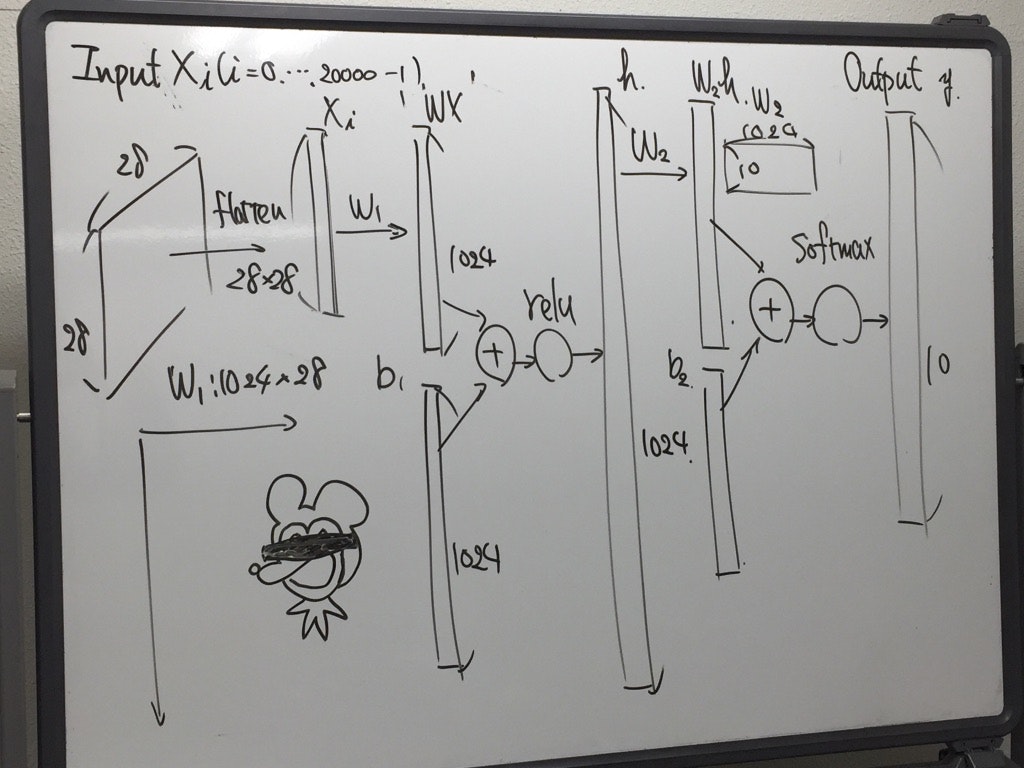Mooc(Udacity, Coursera)で機械学習(Scikit-learn, TensorFlow)をやってました。
Mooc
Andrew Ng先生のが有名だけど、Googleの提供しているDeep Learning - UdacityはScikit-learnとかTensorFlowとか扱っているのがいい感じ
Neural Networks for Machine Learning
- Hinton先生
- 実行環境がOctaveだった
- 諦めてインストールしたけれど今回はそれで終わり
Deep Learning - Udacity
- 課題がJupyter Notebookで与えられるのがすごくいい(動く!)
- 理論面は物足りないかも
- 「あ、苦労してるんだな」って言うシーンがいくつかあるのでオススメ
Deep Learning - Udacity
Setup
- 環境を用意するのが面倒だったのでDocker利用
TensorFlow v1.0が出ていたのでアップデートした
Scikit-learn
一つ目の課題が "Scikit-learnを使ってLogistic回帰しよう" だった
tensorflow/1_notmnist.ipynb at master · tensorflow/tensorflow
Scikit-learn
scikit-learn/scikit-learn: scikit-learn: machine learning in Python
sklearn.linear_model.LogisticRegression — scikit-learn 0.18.1 documentation
L1 Penalty and Sparsity in Logistic Regression — scikit-learn 0.18.1 documentation
Python : 共通する要素の取り出し
v = [1,2,3]
w = [2,3,4]
[x for x in v if x in w] # [2,3]
TensorFlow
Tensorflowで同じタスクを実行する内容だった。
tensorflow/2_fullyconnected.ipynb at master · tensorflow/tensorflow
Assignment 2: 2 hidden layers and NaN loss - Courses / Deep Learning - Udacity Discussion Forum
こんな感じで3層NNを作ってaccuracy 94.2%を達成したので満足した。
コードの一部を抜き出すとこんな感じ。
def weight_variable(shape):
initial = tf.truncated_normal(shape, stddev=1.732/sum(shape))
return tf.Variable(initial)
def bias_variable(shape):
initial = tf.constant(0.1, shape=shape)
return tf.Variable(initial)
batch_size = 128
hidden_layer_size = 1024
input_layer_size = 28*28
output_layer_size = 10
graph = tf.Graph()
with graph.as_default():
# Input data. For the training data, we use a placeholder that will be fed
# at run time with a training minibatch.
tf_train_dataset = tf.placeholder(tf.float32, shape=(batch_size, image_size * image_size))
tf_train_labels = tf.placeholder(tf.float32, shape=(batch_size, num_labels))
tf_valid_dataset = tf.constant(valid_dataset)
tf_test_dataset = tf.constant(test_dataset)
# Variables
weight1 = weight_variable( (input_layer_size, hidden_layer_size) )
bias1 = bias_variable( [hidden_layer_size] )
# Hidden Layer
hidden_layer = tf.nn.relu(tf.matmul(tf_train_dataset, weight1) + bias1)
# Variables
weight2 = weight_variable( (hidden_layer_size, output_layer_size) )
bias2 = bias_variable( [output_layer_size] )
logits = tf.matmul(hidden_layer, weight2) + bias2
loss = tf.reduce_mean(tf.nn.softmax_cross_entropy_with_logits(logits=logits, labels=tf_train_labels))
# optimizer
optimizer = tf.train.AdamOptimizer(0.001).minimize(loss)
# optimizer = tf.train.GradientDescentOptimizer(0.5).minimize(loss)
# prediction
train_prediction = tf.nn.softmax(logits)
valid_prediction = tf.nn.softmax(tf.matmul(tf.nn.relu(tf.matmul(tf_valid_dataset, weight1) + bias1), weight2) + bias2)
test_prediction = tf.nn.softmax(tf.matmul(tf.nn.relu(tf.matmul(tf_test_dataset, weight1) + bias1), weight2) + bias2)
